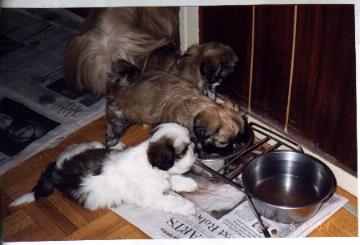FEEDING YOUR NEW PUP
 The following information is my preferred
feeding program for a pup age 5 to 12 weeks. Amounts fed and
numbers of times fed per day vary with the age and size of the individual
puppy. Other breeders may have their own schedule for feeding a puppy. If
your breeder gives you instructions on feeding your new pup, please follow
their recommendations. If you are concerned that you are not feeding the pup
enough food, please visit your veterinarian for further instructions.
The following information is my preferred
feeding program for a pup age 5 to 12 weeks. Amounts fed and
numbers of times fed per day vary with the age and size of the individual
puppy. Other breeders may have their own schedule for feeding a puppy. If
your breeder gives you instructions on feeding your new pup, please follow
their recommendations. If you are concerned that you are not feeding the pup
enough food, please visit your veterinarian for further instructions.
Ask the breeder when you pick up the
pup, how much the pup is eating per meal, and how many times per day, they are
feeding him/her. Also, find out what brand of dog food they are using.
Changing brands of dog food too quickly can cause diarrhea.
Feed your puppy 3-4 meals a day
consisting of 1/4 to 1/3 cup of quality puppy food for each meal. Add 1 teaspoon of canned (lamb & rice or chicken or
puppy food) to dry food (micro-wave the teaspoon of canned food for 10 to 15 seconds to warm then add to dry food).
A bowl of dry dog food should always
be available for nibbling on as the puppy is teething. Do not add canned food to this dish.
Fresh water should always be available. Using a water bottle to drink from helps keep the dogs face
dry and clean (a guinea pig water bottle will do nicely).
Avoid giving the puppy milk as
he/she has never been given cows milk and it may cause diarrhea.
Please
Remember: that as the puppy grows, the amount of food you will feed him/her will
increase (e.g., 1/4c. to 1/3c.,
1/3c. to
1/2c.).
|
|
At approximately 3-4 months,
reduce to 3 meals a day. |
|
|
At 4-6 months, reduce to 2 meals a
day. The puppy should be eating about 1/2 cup or more per feeding. This
amount may vary from day to day depending on activity level of the pup. |
|
|
At 6 to 8 months, reduce to 1 meal
a day. Biscuits (1 or 2) may be given in the morning and again in the evening
for a snack if the puppy is hungry in between. Many people prefer to feed their dog twice a day. This is ok as long as you are not overfeeding him/her. A fat puppy / dog is NOT a healthy dog. |
|
|
At 1 year, your dog should be put
on Adult dog food. He / She should be eating
approximately 1 cup per day. If the dog cannot seem to eat 1 cup of food all
at once, you can feed him/her 1/2 in the a.m. and the other 1/2 in the
evening. |
Always introduce a new food very
gradually
and check to ensure that the puppy does not develop diarrhea.
Proper nutrition is
very important
to the development and growth of your puppy. Feed him/her a good quality, high protein dog food.
Treats should be restricted to dog
treats only. Dog cookies are an excellent treat
and help to reduce tartar on teeth, but do not overdo it. Too many treats will cause your pup to eat less dog food. He / She will not be getting all the nutrients he/she needs
to grow up healthy and strong.
Brewers' yeast & garlic tablets
help to promote a healthy coat and reduces the chance of getting fleas. This may be added to his/her dog food or they can chew it.
Dogs do not need variety in their
diet. Changing food can cause upset
stomach & diarrhea.
Gumabones or Nylabones are a wise choice for a chew toy
DO NOT FEED: REAL BONES EVER
DO NOT FEED: CHOCOLATE EVER AS IT IS TOXIC
TO DOGS.
DO NOT FEED: TABLE SCRAPS except
as an occasional treat
( no more than 10% of the dog’s meal.)
NEVER
let your puppy chew on houseplants
as many are poisonous. E.g.
English Ivy, Dieffenbachia, Philodendron, and Caladium.